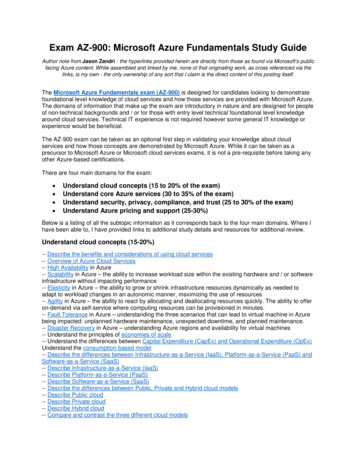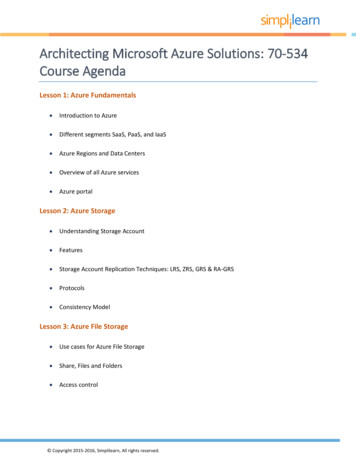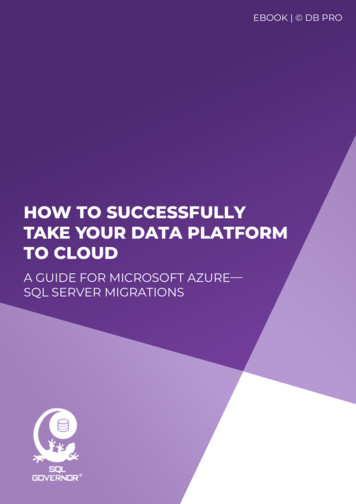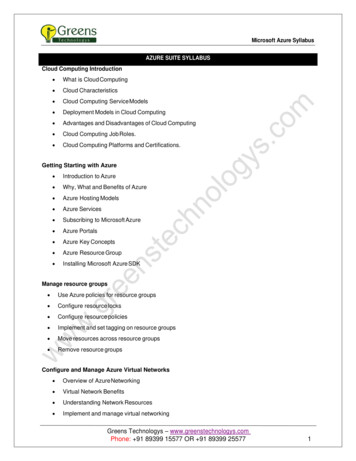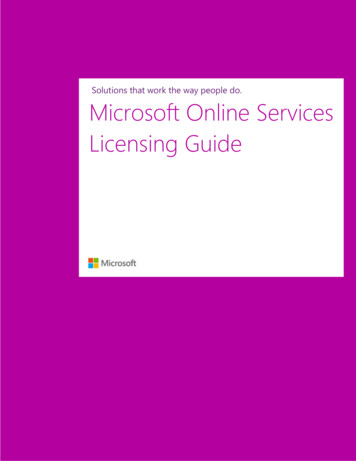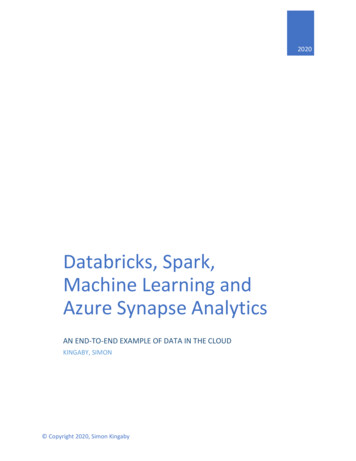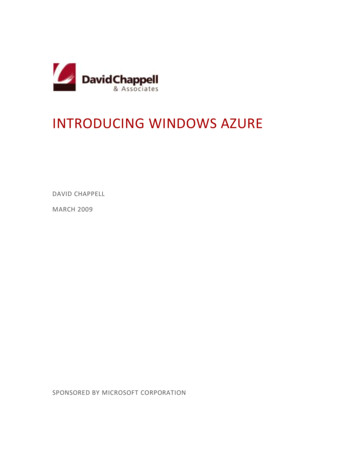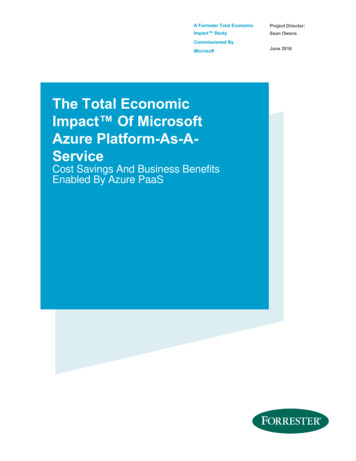
Transcription
A Forrester Total EconomicProject Director:Impact StudySean OwensCommissioned ByMicrosoftThe Total EconomicImpact Of MicrosoftAzure Platform-As-AServiceCost Savings And Business BenefitsEnabled By Azure PaaSJune 2016
Table Of ContentsExecutive Summary . 3Disclosures . 4TEI Framework And Methodology . 5Analysis . 6Financial Summary . 22Microsoft Azure: Overview . 23Appendix A: Composite Organization Description . 24Appendix B: Total Economic Impact Overview . 25Appendix C: Forrester And The Age Of The Customer . 26Appendix D: Glossary . 27Appendix E: Endnotes . 27ABOUT FORRESTER CONSULTINGForrester Consulting provides independent and objective research-basedconsulting to help leaders succeed in their organizations. Ranging in scope from ashort strategy session to custom projects, Forrester’s Consulting services connectyou directly with research analysts who apply expert insight to your specificbusiness challenges. For more information, visit forrester.com/consulting. 2016, Forrester Research, Inc. All rights reserved. Unauthorized reproduction is strictly prohibited.Information is based on best available resources. Opinions reflect judgment at the time and are subject tochange. Forrester , Technographics , Forrester Wave, RoleView, TechRadar, and Total Economic Impactare trademarks of Forrester Research, Inc. All other trademarks are the property of their respectivecompanies. For additional information, go to www.forrester.com.
3Executive Summary“Developing our app without PaaS? Well, weMicrosoft commissioned Forrester Consulting to conduct awouldn’t have done it. Frankly, the extra time andTotal Economic Impact (TEI) study to examine the potentialresources required would have wiped out anyreturn on investment (ROI) enterprises may realize by shiftingprofit that we have generated.”their application development and deployment to Azure— Strategist and founder of a US IT services firmplatform-as-a-service (PaaS). The purpose of this study is togive readers a framework to evaluate the potential financialimpact, or ROI, of leveraging Azure PaaS for theirorganizations. This ROI represents benefits gained by customers that moved from infrastructure-as-a-service (IaaS) toplatform-as-a-service (PaaS). For customers migrating from on-premises environments to PaaS, the return on investmentcan be even greater. PaaS allows customers to focus on application innovation without the complexity of building andmaintaining the underlying infrastructure, and removes the need to perform many IT tasks like patching, networking, andserver management.To better understand the benefits, costs, and risks associated with an Azure PaaS implementation, Forrester interviewedeight customers that had several years of experience with Azure IaaS and had more recently adopted Azure PaaS. Theyleverage specific service offerings such as App Service, SQL Database, and Azure Active Directory.With Azure PaaS, customers were able to streamline and automate processes across key functions and lines of business,enabling them to meet their objectives, keep costs in check, and increase revenue. They also said that the ease ofdevelopment and management meant more applications were created and updated, providing greater value to theorganizations and their customers. The strategist and founder of a US IT services firm said: “Developing our app withoutPaaS? Well, we wouldn’t have done it. Frankly, the extra time and resources required would have wiped out any profit thatwe have generated.”Forrester created a representative organization based on the composite results of the interviews with the customerorganizations: a medium-size business with 100 applications now supported by Azure PaaS (and more planned each year).AZURE PAAS HELPS IMPROVE TIME-TO-MARKET AND REDUCE MANAGEMENT TIMEInterviews with existing Azure PaaS customers and subsequent financial analysis found that the representative organization1based on these organizations experienced the risk-adjusted ROI, benefits, and costs shown in Figure 1. See Appendix A fora description of the representative organization.The representative organization five-year analysis estimates a 466% ROI and a net present value (NPV) of more than 5.9million. Key improvements enabled by Azure PaaS include an 80% reduction in IT administration time required to manageapps deployed on the platform, a 25-hour average reduction in development and testing time required to develop or updateAzure PaaS applications, and a 50% reduction in time required to help deploy a new application solution to a client.FIGURE 1Financial Summary Showing Five-Year Risk-Adjusted ResultsROI:466%NPV: 5,913,807Source: Forrester Research, Inc.IT time: 80%Dev/test: 25hrs./appTime-tomarket: 50%
4››Benefits. The representative organization, based on current Azure customers, saw the following risk-adjusted benefits: Eighty percent less IT administration time was required for applications on PaaS, allowing the organizationto focus on application innovation, not administrative tasks. The organization used to spend significant time onserver patching, networking setup, firewall configuration, and many other server-related tasks now included withAzure PaaS. This adds up to 132,240 saved in the first year. IT teams can reallocate or avoid hiring five IT administrators and two database administrators (DBAs) toother teams or more value-added tasks, adding up to 697,000 saved per year. The organization would haveneeded to hire five new IT administrators and two DBAs within the first year to meet the demand and serviceotherwise enabled by Azure PaaS. The organization improved application delivery time-to-market by 50% with Azure PaaS, leading to 376,441in increased profit in the first year. The organization could deliver applications running on Azure in half the time,meaning revenue could be earned more quickly. The organization saved 25 hours in application testing and development time per application created orupdated, improving developer productivity and adding up to 108,458 saved in the first year. With AzurePaaS, developers can take advantage of integrated tools and, with the push of a button, testers can create newtesting environments that exactly match the organization’s development and production environments. The organization saw 98,550 in employee issue identification and repair resource cost savings in the firstyear. The representative organization deployed an employee-facing mobile application on Azure PaaS to meet aspecific need related to facilities issue identification and repair, saving significant time and resource costs comparedwith the earlier paper-based processes. The organization deployed customer-facing applications, leading to 168,750 in the first year in new profitfrom improved sales rep performance and direct customer sales. Both customer self-service and salesenablement apps are easier to develop and contribute to new revenue and profit for the organization.Costs. The representative organization experienced the following risk-adjusted costs: Initial implementation costs of 101,850 and ongoing resource and other costs related to Azure PaaS of 73,500 in the first year. While significant administration, development, and testing costs can be saved with AzurePaaS, some implementation, training, and management costs are expected. Azure subscription and support fees of 191,400 in the first year. These are the estimated annual fees therepresentative organization paid to Microsoft for Azure PaaS services, billed monthly on a per-use basis.DisclosuresThe reader should be aware of the following:››››The study is commissioned by Microsoft and delivered by Forrester Consulting. It is not meant to be used as a competitiveanalysis.Forrester makes no assumptions as to the potential ROI that other organizations will receive. Forrester strongly advisesthat readers use their own estimates within the framework provided in the report to determine the appropriateness of aninvestment in Microsoft Azure PaaS.Microsoft reviewed and provided feedback to Forrester, but Forrester maintains editorial control over the study and itsfindings and does not accept changes to the study that contradict Forrester's findings or obscure the meaning of the study.Microsoft provided the customer names for the interviews but did not participate in the interviews.
5TEI Framework And MethodologyINTRODUCTIONFrom the information provided in the interviews, Forrester has constructed a Total Economic Impact (TEI) framework forthose organizations considering implementing Microsoft Azure PaaS. The objective of the framework is to identify the cost,benefit, flexibility, and risk factors that affect the investment decision, to help organizations understand how to takeadvantage of specific benefits, reduce costs, and improve the overall business goals of winning, serving, and retainingcustomers.APPROACH AND METHODOLOGYForrester took a multistep approach to evaluate the impact that Microsoft Azure PaaS can have on an organization (seeFigure 2). Specifically, Forrester:›››››Interviewed Microsoft marketing, sales, and/or consulting personnel, along with Forrester analysts, to gather data relativeto Azure PaaS and the marketplace for Azure PaaS.Interviewed eight organizations currently using Microsoft Azure PaaS to obtain data with respect to costs, benefits, andrisks. Most also previously used or currently use Microsoft Azure IaaS and were able to provide some comparisonexperiences.Designed a representative, composite organization based on characteristics of the interviewed organizations (seeAppendix A).Constructed a financial model representative of the interviews using the TEI methodology. The financial model ispopulated with the cost and benefit data obtained from the interviews as applied to the representative organization.Risk-adjusted the financial model based on issues and concerns the interviewed organizations highlighted in interviews.Risk adjustment is a key part of the TEI methodology. While interviewed organizations provided cost and benefitestimates, some categories included a broad range of responses or had a number of outside forces that might haveaffected the results. For that reason, some cost and benefit totals have been risk-adjusted and are detailed in eachrelevant section.Forrester employed four fundamental elements of TEI in modeling Microsoft Azure PaaS: benefits, costs, flexibility, and risks.Given the increasing sophistication that enterprises have regarding ROI analyses related to IT investments, Forrester’s TEImethodology serves to provide a complete picture of the total economic impact of purchase decisions. Please see AppendixB for additional information on the TEI methodology.FIGURE 2TEI ApproachPerformdue diligenceSource: Forrester Research, rganizationConstructfinancialmodel usingTEI frameworkWritecase study
6AnalysisREPRESENTATIVE ORGANIZATIONFor this study, Forrester conducted a total of eight interviews withrepresentatives from the following companies, which are Microsoftcustomers based in the US:›Worldwide retail eCommerce firm based in Asia.›Boutique IT services firm in the Northwestern US.›Midsize European consulting and services organization.›Transportation authority for a large European city.›Small BI solution provider in the Southeastern US.›“We had to manage patchingof the SQL Server itself. Also,we would have to tell a DBA toworry about updating patchesand do a lot more testing,especially performance testingto make sure that scales areleveled that we need in.” Senior executive, global eCommerce firmMidmarket procurement software and services provider based inthe US.›Small development firm in the US focused on software and solutions for healthcare.›Midmarket enterprise content and information management services provider based in Europe.FIGURE 3Interviewed OrganizationsMidmarket procurementsoftware and service providerBoutique ITservices firmTransportationauthority for a large citySmall BI solutionproviderSmall software and servicesprovider for healthcareSource: Forrester Research, Inc.Midsize consulting andservices organizationMidmarket content and informationmanagement service providerWorldwide retaileCommerce firm
7Based on the interviews, Forrester constructed a TEI framework, a composite model, and an associated ROI analysis thatillustrates the areas financially affected by an Azure PaaS implementation. The representative organization that Forrestersynthesized from these results represents an organization with the following characteristics:›It is a US-based eCommerce services firm that uses apps deployed on Azure PaaS to assist sales reps, allow customersto access services and make small purchases, and sell services to business customers.›It has 2,000 employees, about 750 of whom use one or more internal apps deployed on Azure PaaS.›Azure PaaS was added in the past year.›››››The organization had been a consumer of Azure IaaS for several years (and has continued to be a consumer of AzureIaaS, though at a smaller scope).It deployed 100 apps (many related to simple internal processes and web applications) on Azure PaaS, with new andupgraded apps expected to grow that number each year.A small set of apps deliver sales enablement support to internal sales reps.A handful of those apps deployed to Azure PaaS deliver direct-to-customer services, such as a retail sales site and hostedbusiness-to-business (B2B) services.The organization sells on-premises solutions, but since adopting Azure PaaS, it sells cloud services more often.INTERVIEW HIGHLIGHTSThe representative organization, based on the business goals stated by interviewed organizations, was able to resolvebusiness issues and take advantage of new opportunities.SituationBefore Azure PaaS, the organization identified a few issues it wanted to improve or resolve:››››Application development and testing was often delayed due to environment setup, verification, and correction tasks; if thedevelopment and test environments don’t match production, issues can be missed and rework is required.Resource time, including some resources with specialty skills, was required to deal with repetitive and what seemed likeunnecessary tasks, such as needing to hire a DBA to manage new applications.Some very useful but noncritical applications were not updated oreven developed in the first place. Such applications could save alot of employee time and costs and potentially generate newrevenue.Solution deployments for the organization’s customers were verylong and drawn out. Long waits and time-consuming tasksincluded: waiting for hardware deliveries, configuring and testingservers, deploying and integrating software, and monitoring andsupporting any issues post deployment.SolutionAs an Azure infrastructure services customer, the organizationrealized that Azure’s recent PaaS advancements targeted a“We used to have to set updevelopment environments,QA systems, and completeinfrastructure tasks. All thatstuff. It wasn’t a stretch tospend 50 days on that.” Partner at a European consultancy
8number of issues that it wanted to investigate. Azure PaaS was agreat fit to help leverage its existing Azure infrastructure servicesand take advantage of specific IT and business improvement, costsaving, and revenue opportunities.ResultsThe interviews revealed that:›››Azure PaaS offerings can enable significant IT savings.Infrastructure-as-a-service provides computing resources that anorganization can configure for just about anything it needs, but itrequires a lot of management and setup. Azure PaaS delivers anapplication platform that ensures consistency and simplicity.Many IT tasks, like patching, updating, testing, networking, andothers, are built in. The representative organization found:“We try to adopt the latestcloud-designed patterns andnew services Microsoft offersto understand how it could beused and leveraged in existingand future projects.” Senior executive, global eCommerce firm It can realize significant savings in the time required for the current IT team to manage apps running on Azure PaaS.“For a standard digital project, we don’t even need an infrastructure team anymore for apps running on Azure,” saidthe partner at a European consulting firm It can avoid significant IT and DBA future hires that had been planned before Azure PaaS was implemented.The availability of new and improved apps with Azure PaaS helped employees save time. Sales has better tools inclient discussions, customers can more easily find and buy products and services, and the organization delivers solutionsto its customers more efficiently. Apps can be more quickly and easily developed on Azure PaaS, even for a variety ofmobile platforms, so more apps are likely to be developed or migrated from legacy systems, not just the few top-priorityones. Employees armed with these apps can, for example, help identify facilities issues more quickly and accurately, so arepair person can be sent out faster, and with the right parts and tools to reduce time and costs. Revenue-generating apps (whether customer self-service apps or sales enablement tools for sales reps to use incustomer discussions) can help generate new revenue and profit. Solution delivery to customers and continuous innovation are much quicker with Azure PaaS. Applications aredeveloped and tested on the same platform, and applications can be set up and deployed with the push of a button.The organization is also able to send fewer technicians to customer sites to support solution delivery and integration.Applications that are developed for Azure PaaS deploymenttake less time to develop and test. New apps, migrated apps,and updated or upgraded apps all saw improvement in the timerequired to develop and test them to be ready for production. Inparticular, significant time and cost is saved in the testing phase.Testers can press a button to create a test environment thatexactly matches development and production, so they can starttesting immediately and avoid any rework related to testing on anenvironment that isn’t the same. Testers can also turn off and notpay for the environment when it’s not needed, unlike with onpremises servers.“For a standard digital project,we don’t even need aninfrastructure team anymorefor apps running on Azure.” Partner, European consulting firm
9BENEFITS›IT administration resource savings.›Avoided and reduced IT resource costs.›Improved service deployment time-to-market.“If I was doing this without[Azure] PaaS I would . . . haveto care about scaling for everysingle one of those dozens ofwebsites.”›Application testing resource savings. Strategist and founder of a US IT services firm›Application-enabled organization savings.›New business opportunities enabled by Azure PaaS.The representative organization experienced a number ofquantified benefits in this case study:The organization expects Azure PaaS consumption to grow in later years, as more applications are deployed and managedwith those services. An estimated growth rate has been applied for some benefits.IT Administration Resource SavingsWith Azure PaaS, many server tasks for an on-premises or even IaaS implementation are no longer required.These tasks are included in Azure PaaS, as it provides an application platform ready for application deployment,not raw computing resources.TABLE 1IT Administration Resource SavingsRef.MetricCalculationYear 1Year 2Year 3Year 4Year 5A1Applications supported by AzurePaaS100110121133146A2Environments supported per app,before Azure PaaS33333A3Server buildout/update times per year22222A4IT administrator mgmt. time requiredper server (hours)55555A5Average IT hourly rate 58 58 58 58 58A6Percentage of IT admin time savedwith Azure PaaS80%80%80%80%80%AtIT administration time saved 139,200 153,120 168,432 185,136 203,232 132,240 145,464 160,010 175,879 193,070Risk adjustmentAtrIT administration time saved (riskadjusted)Source: Forrester Research, Inc.A1 * A2 * A3 *A4 * A5 * A6 5%
10“It’s very easy to provision new resources fromAzure,” said the chief technology officer (CTO) at anenterprise content and information managementservices provider. The CEO of the healthcaresoftware and services provider added: “Let me put itto you this way: We have thousands of servicesupport calls each year. Last year, only 4% of thosewere attributed to our product line on Azure — abouthalf as many as it would have been.”FIGURE 4IT Resource Hours Saved With Azure PaaS5,000Hours beforeHours after4,0003,000The representative organization deployed 100 apps in2,000the first year on Azure PaaS, with more apps addedin future years due to planned and organic growth.1,000Before Azure PaaS, those apps required multipleenvironments (production, development, and test),Year 1 Year 2 Year 3 Year 4 Year 5which were each updated about every six months. “If Iwas doing this without [Azure] PaaS, I would have toSource: Forrester Research, Inc.spin up a server, and inside the server spin updozens upon dozens of different websites, which Ihave to coordinate and manage. I have to care aboutscaling for every single one of those dozens of websites,” said the strategist and founder of the US IT servicesfirm, discussing his portfolio of web applications. The total estimated hours both before Azure PaaS and sinceare shown in Figure 4.With Azure PaaS, the organization has seen a significant reduction in time required to manage and support theseapplications. These savings range from 139,200 in Year 1 to 203,232 in Year 5.Since the time required to manage each application can vary, a small risk adjustment has been applied. The riskadjusted annual benefits range from 132,240 in Year 1 to 193,070 in Year 5. See the section on Risks formore information.Avoided And Reduced IT Resource CostsWith the time savings enabled by Azure PaaS, applications can be developed and tested more quickly, often withless complexity. Services such as Azure SQL Database and Azure Active Directory can help simplify the codingand testing of applications, avoiding the need for high-skilled future hires.Azure SQL Database can also enable easier data management, so the organization can focus on using datarather than dealing with indexes and other data management tasks. “We don’t have large IT, IT ops, anddeveloper ops teams; we’re going to do everything asefficiently as possible,” said the chief architect at a BIsolution provider. “If we were doing this in our own datacenter, I’d need to hire several DBAs, DevOps, andsystems networking people.”The organization developed several key apps on AzurePaaS. It estimated that these apps not only savedconsiderable time but also helped avoid extraresources, such as a dedicated IT manager or DBA.The organization estimates it would have needed tohire five IT resources and two DBAs within a year ofdeveloping key applications without Azure PaaS. With“We don’t have large IT, ITops, and developer ops teams;we’re going to do everythingas efficiently as possible.” Chief architect at a BI solution provider
11Azure PaaS, it is able to avoid the cost of hiring those people; or, if they are already hired, it could reassign themto a higher priority project (thus avoiding the need to hire more people for that project). These resource savingsadd up to 820,000 each year.TABLE 2Avoided And Reduced IT Resource CostsRef.MetricCalculationYear 1Year 2Year 3Year 4Year 5B1IT FTE headcount reallocated oravoided with Azure PaaS5.05.05.05.05.0B2DBA FTE headcount reallocated oravoided with Azure PaaS2.02.02.02.02.0B3IT admin annual salary (average) 120,000 120,000 120,000 120,000 120,000B4DBA annual salary (average) 110,000 110,000 110,000 110,000 110,000BtAvoided and reduced headcountcostsB1*B3 B2*B4 820,000 820,000 820,000 820,000 820,000Risk adjustment 15% 697,000 697,000 697,000 697,000 697,000BtrAvoided and reduced headcountcosts (risk-adjusted)Source: Forrester Research, Inc.Since salaries can vary, a risk adjustment has been applied. The risk-adjusted annual benefit is 697,000 peryear. See the section on Risks for more information about Forrester’s TEI approach to risk adjustment.Improved Service Deployment Time-To-MarketThe representative organization also sells and deploys software solutions to its customers via the cloud. UsingAzure PaaS, it can deliver improved services to its customers without having to manage and support onpremises server deployment projects; it can also deliver service updates and patches much more quickly andreliably. The organization has seen significant deployment time savings, allowing it to deliver software andservices much more quickly, leading to a significant increase in revenue and profit.Interviewed organizations highlighted a number of pains they can now avoid (such as on-premises infrastructuretesting and implementation) to help improve the business and lead to greater customer satisfaction:›“We were working with a client, and it took them six months to give us a test server. [With Azure] I can have atest server in 10 minutes — or, you know, pretty much any feature in 10 minutes,” said the chief architect of theBI solution provider. “For any on-premises project, we’d have to add a month to two months for deployment.”›“We were pitching our solution to a client, and it took only 2 hours to get it up and running [with Azure]. It’s noteven about saving working hours, but being able to do something today and not in two and a half weeks. Thatmakes a huge difference when you’re competing for a client win,” said the CTO at an enterprise andinformation content services provider.›“Within the new Azure app service, you can have deployment literally in seconds,” said the partner at aEuropean consultancy.
12Being able to deploy software and services more quickly can lead to a number of benefits, such as improvedcustomer satisfaction and increased resource productivity. Increased revenue and profit is used as the summarymetric enabled by these improvements. The organization estimates that before Azure PaaS, it conducted 20deployments per year, but with Azure PaaS it could support more deployments (met with an increase in salesefforts). Delivering each application two weeks sooner leads to added revenue, now that its product can belicensed as an ongoing subscription. The benefit is the total profit gained from all net-new deployments (that theorganization previously didn’t have time to get to as quickly), plus the incremental profit gained from fasterdeployments. This ranges from 501,921 in Year 1 to 1,156,151 in Year 5. Ongoing patching and updatedelivery is also much easier to manage with Azure, though this was not quantified. Ensuring most or allcustomers are on the latest software can help reduce security and technical support questions, and not having tosend as many support technicians (or even any at all) to a customer location saves significant time and travelexpenses.TABLE 3Improved Customer Application Service Deployment Time-To-MarketRef.MetricCalculationInitialYear 1Year 2Year 3Year 4Year 5C1New customer servicedeployments per year203033364044C2Customer deploymenttime (weeks)422222C3Revenue per newcustomer deploymentper year (estimated) 300,000 300,000 300,000 300,000 300,000 300,000C4Revenue per customerper week 5,769 5,769 5,769 5,769 5,769 5,769C5Profit margin15%15%15%15%15%15% 0 501,921 642,113 782,305 969,228 1,156,151 0 376,441 481,585 586,729 726,921 867,113CtDeployment time forrevenue improvementwith Azure PaaSRisk adjustmentCtr((C1 growth) *C3 C1 * (C2reduction) *C4) * C5 25%Deployment time forrevenue improvementwith Azure PaaS(risk-adjusted)Source: Forrester Research, Inc.Given the broad range of revenue per project and the number of influences that can affect revenue beyonddelivering a cloud solution, a high risk adjustment has been applied. The risk-adjusted totals range from 376,441 in Year 1 to 867,113 in Year 5. See the section on Risks for more information about Forrester’s TEIapproach to risk adjustment.Application Testing Resource SavingsWith Azure PaaS, developers and testers can quickly create a development or testing platform configured to beexactly the same as their production environment. “I think probably the biggest cost in terms of testers’ time is to
13conduct regression testing on the app when theproduction environment changes,” said the seniorexecutive of the global eCommerce firm.First, the spin-up process itself is much faster thanbefore — even the previous IaaS environment requiredspecific computing setup steps for dev and test, andmay or may not have included all the same settings andinteractions as the production environment. Second,with identical development, test, and productionenvironments, application errors related to platformchanges are all but eliminated.The representative organization had already migratedto Azure IaaS from its previous on-premises solution, sosavings there have already been realized and are notincluded in this analysis. Organizations might includecost savings related to retiring on-premises infrastructure.“I think probably the biggestcost in terms of testers’ time isto conduct regression testingon the app when theproduction e
impact, or ROI, of leveraging Azure PaaS for their organizations. This ROI represents benefits gained by customers that moved from infrastructure-as-a-service (IaaS) to platform-as-a-service (PaaS). For customers migrating from on-premises environments to PaaS, the return on investment can be even greater.

